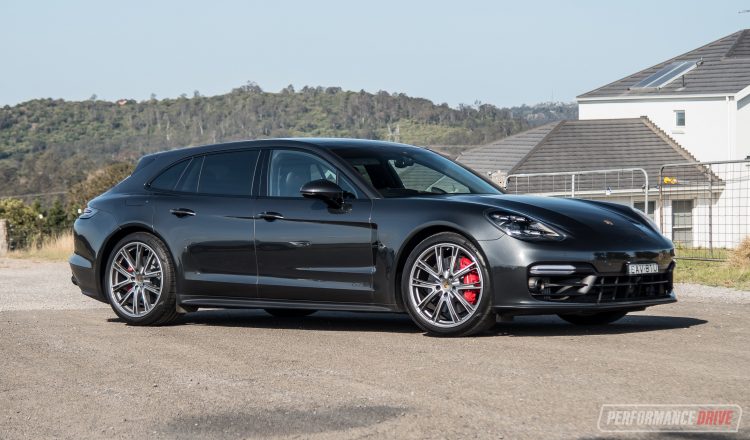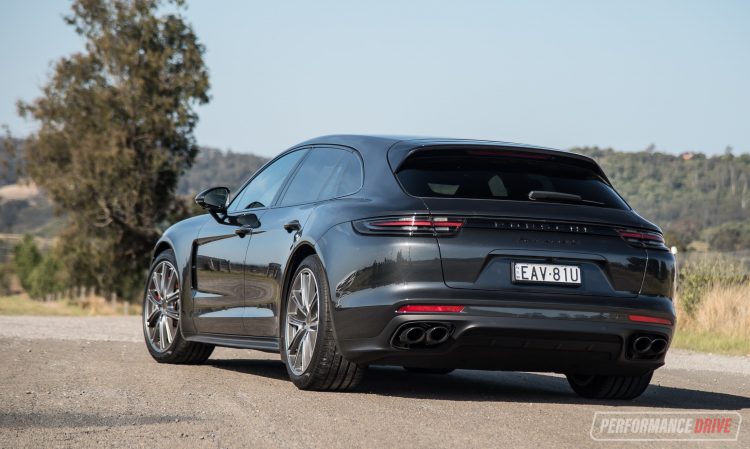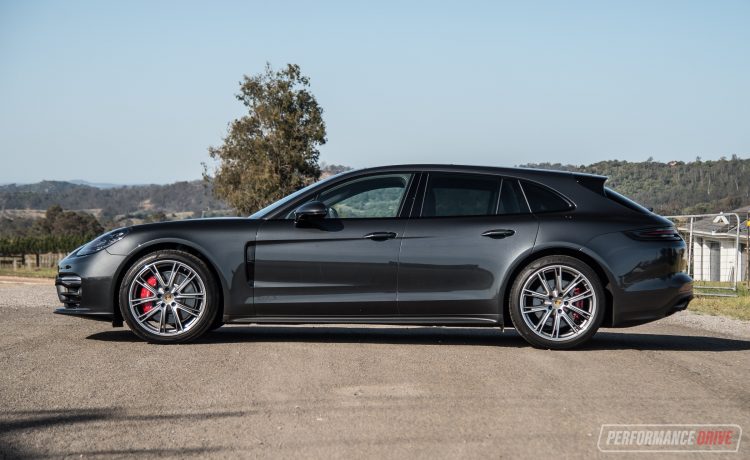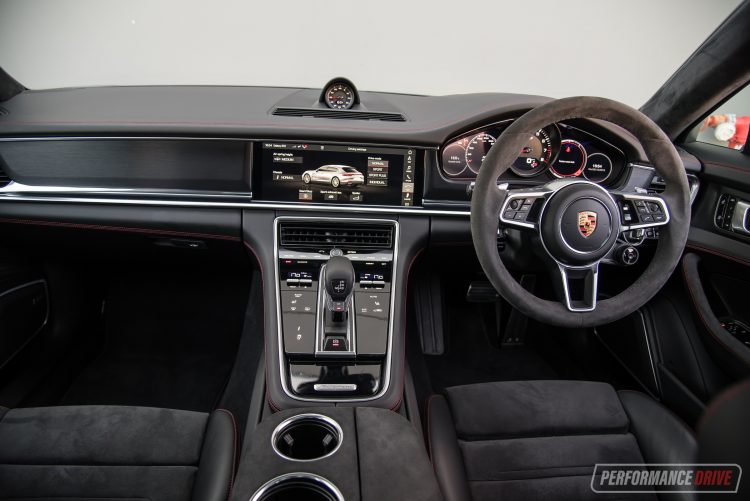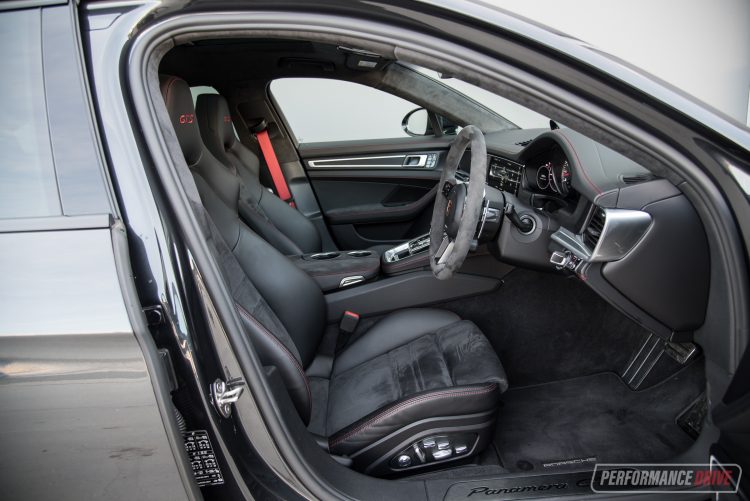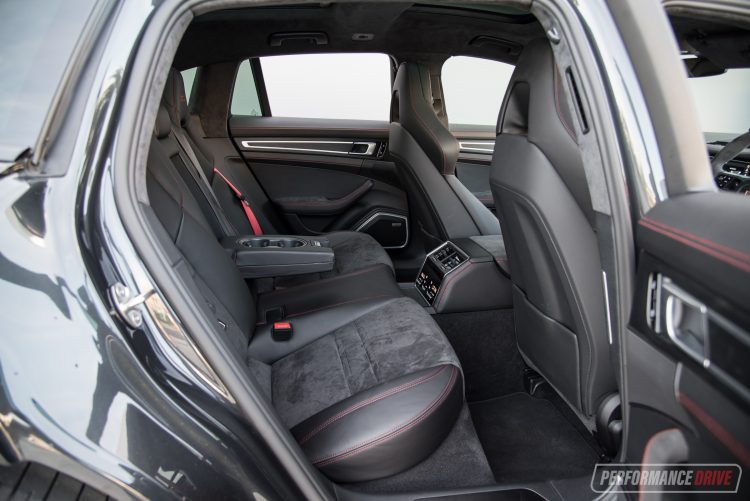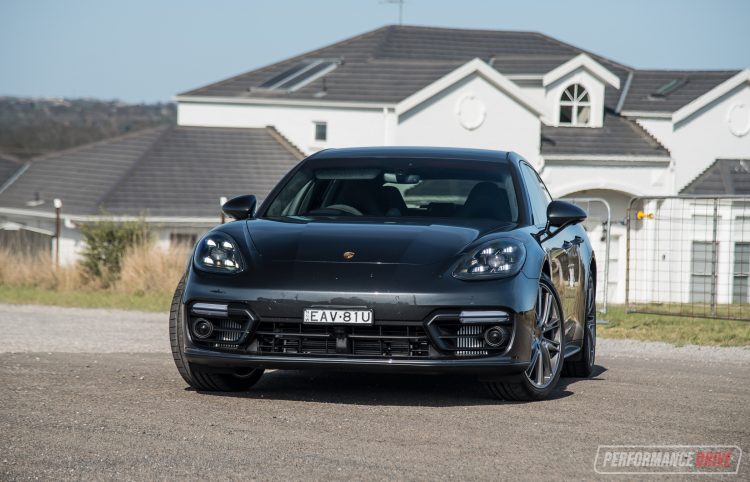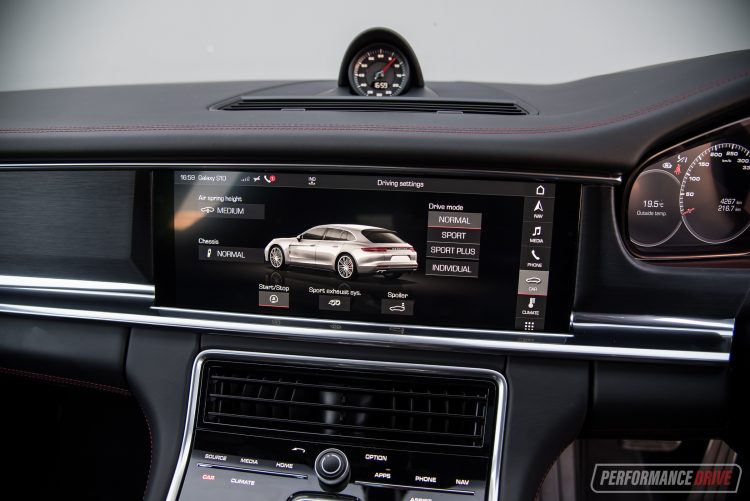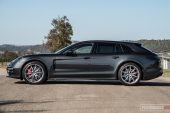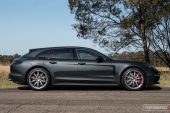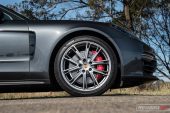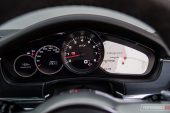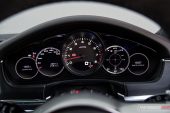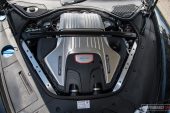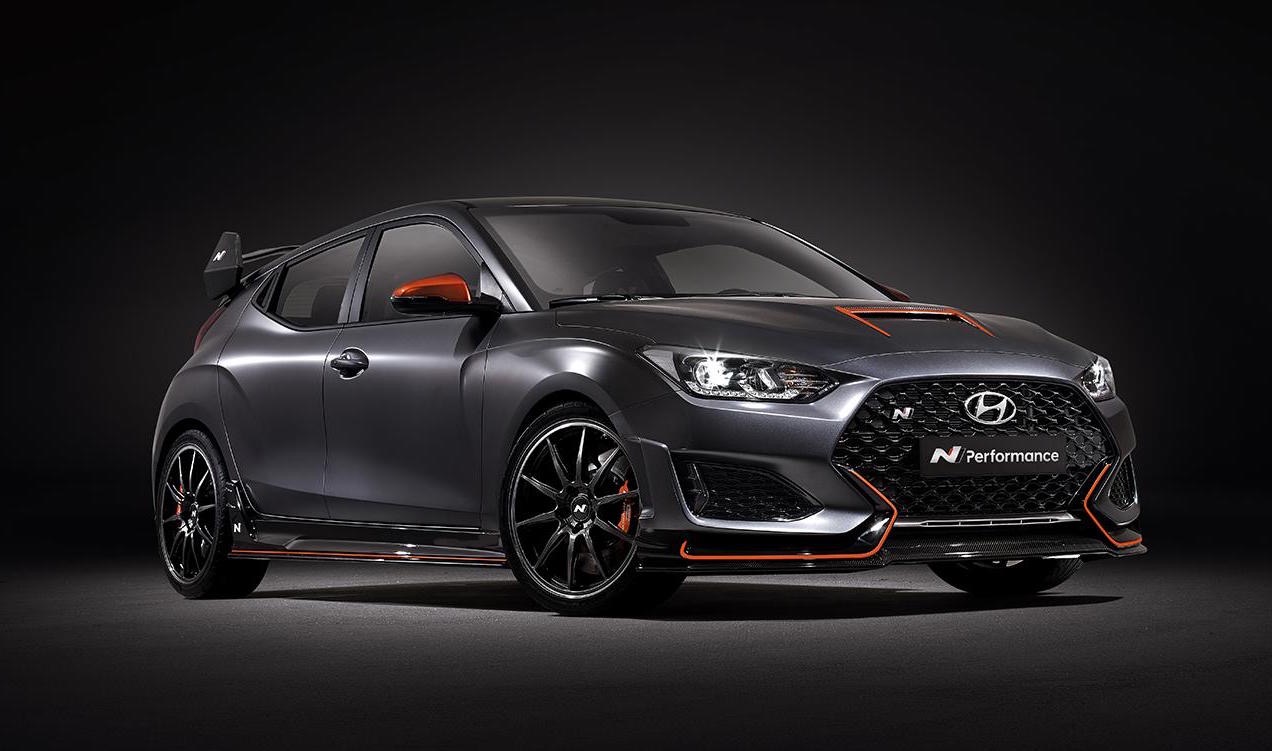What’s this, a wagon? Instantly cool, right? The 2019 Porsche Panamera GTS Sport Turismo is one of the most exclusive station wagons on the new car market, and one of the most expensive. In fact, the only cars stopping it from being number one in these two areas are its siblings; the Turbo and the Turbo S E-Hybrid.
If you’re not completely up to speed on modern Porsches, the GTS badge usually means things are quite serious, but just short of the respective flagships for each model line. In the case of the latest Panamera, the GTS slots beneath the Turbo and Turbo S E-Hybrid, but above the base Panamera 4, 4 E-Hybrid, and the 4S, completing the six-tier lineup. It comes with a range of performance-focused highlights, including a bespoke tune for the engine and adjustable air suspension, and a higher-than-standard set of features.
The price? It’s best to rip it off like a bandaid, because it starts from a wallet-quivering $374,400. Ouch, indeed. But at this end of the market the Panamera GTS Sport Turismo will appeal to its targeted clientele thanks to its pure exclusivity, and the fact that it prowls around in the wild with no direct rivals.
2019 Porsche Panamera GTS Sport Turismo – THE SPECS
[column width=”47%” padding=”6%”]Engine: 4.0-litre twin-turbo V8
Output: 338kW@6000rpm / 620Nm@1750-5500rpm
Transmission: Eight-speed dual-clutch auto
Drive type: All-wheel drive
Wheels: F: 20×9.5, 275/40 R: 20×11.5, 315/35 (optional 21s fitted)
ANCAP: Not tested
Tare weight: 1967kg
Power-to-weight: 5.82:1 (kg:kW)
Official fuel economy: 11.1L/100km
Economy during test: 11.5L/100km
Fuel capacity/Type: 90L/98 RON[/column] [column width=”47%” padding=”0″]Power efficiency: 30.45kW:L/100km
0-60km/h: 1.84 seconds*
0-100km/h: 4.07 seconds*
0-200km/h: 14.39 seconds*
60-110km/h: 2.82 seconds*
1/8 mile: 7.88 seconds at 148.2km/h*
1/4 mile: 12.19 seconds at 187.1km/h*
Max acceleration: 1.305g
100-0km/h braking: 2.82 seconds at 34.63 metres*
Max deceleration: -1.401g
Decibel at idle (sport mode): 50/56*
Peak decibel at 60-100km/h: 94*
Priced from: $374,400 ($397,130 as tested)[/column][end_columns]
* Figures as tested by PerformanceDrive on the day. Factory claims may be different
2019 Porsche Panamera GTS Sport Turismo – THE PACKAGE
Let’s start with the exterior. In person, this thing looks fat. It’s a monster, engorging every scene that it’s parked in or driving through. You can’t help but instantly bow down in respect and move out of its way. And we think that big price actually helps in this regard, as you aren’t likely to see more than one of these in any given month (or year?).
From the front it showcases Porsche’s trademark slanted nose with big, beady headlights that incorporate four-prong daytime running LEDs. Down below, it’s all about intake. In the middle is a large inlet for the radiator, with aluminium intercoolers nestled neatly in the corners. From the side profile the Sport Turismo body style becomes more evident, and it’s from here you can see the angle of swooping D-pillar and tailgate.
At the back is the best view of all, we reckon. The new full-width taillight design that’s been introduced for the latest-generation Panamera, along with the muscular rear haunches, give it a really wide and low stance. It looks mean and extremely powerful, particularly with quad-outlet exhausts discreetly poking through. On the GTS the exhaust outlets are featured in black, matching the black window trims and other black garnishes that form the standard-for-GTS SportDesign pack.
We think it’s a well-executed piece of design overall, for a Porsche. It’s strong and purposeful, and carries through loads of heritage. And in typical Porsche style, it isn’t too showy. We particularly like it in this Volcano grey metallic colour with the optional 21-inch Porsche Exclusive Design alloy wheels.
The GTS does come with some unique aero parts for the exterior, however, according to the specs the GTS is the least aerodynamic of all variants. While the entry Panamera 4 offers a drag coefficient of just 0.29, and 0.30 for the rest, the GTS is rated at 0.33. The specs also say the GTS is the lowest of all Panamera roof heights, standing at 1422mm. This is due to a bespoke sports air suspension system which lowers the ride height by 10mm over any other variant. It’s also the longest model, measuring a substantial 5053mm (all others are 5049mm).
For this amount of money you’d want a very special interior. Fortunately, the Panamera feels convincingly expensive and unique. Most of the controls are now digital, which means the cascading centre console is elegantly black when the car is off. All of the buttons and controls burst into life only once the car is turned on.
The dash design with its horizontal ledge on the passenger side is a direct nod to generations of 911, helping to create a clean and clutter-free ambience. Sitting in the centre of the dash is Porsche’s latest touch-screen media interface. You can configure the home screen to arrange your favourite tiles/apps, and there are lots of settings and media options to play around with. It’s not the easiest interface around in terms of functionality and menu placement, but the graphics are very crisp, with a distinct Porsche quality to the way everything works and looks.
Seating space in the front is plentiful. There’s a pair of GTS-specific, thickly-bolstered sports seats to cradle you, complete with red stitching and GTS embroidery. You can really hunker down for a race-like driving position, or raise up the seat for an SUV-like stance. This is thanks to the widely-adjustable power seat and steering column. And of course the steering wheel sits perfectly centred at your chest, with superb pedal placement below.
In the back there are three seat belts available. However, the two outer positions feature essentially individual, specially-contoured seats to match those in the front. Meanwhile, the middle seat seems like it is fundamentally there for emergencies and as a last resort. This notion is further amplified by the chunky climate control panel which occupies much of the space around the middle seat legroom. Headroom is very respectable in the back, as with legroom, for the outer seats.
Being a wagon obviously means practicality is one of the Sport Turismo’s fortes. Open the standard electric tailgate and you’ll be presented with 520L of storage volume, expanding to 1390L with the rear seats folded down. That’s about the same volume as a mid-size SUV, which means it’ll easily swallow a week’s worth of luggage for those busy business trips or vacations with the family. Although, if you want more space you can step over to the Cayenne Turbo, which offers 745L/1680L.
2019 Porsche Panamera GTS Sport Turismo – THE DRIVE
Upon first start-up, you just know you’re in for a thrilling ride. The 4.0-litre twin-turbo V8 rumbles and crackles, resting with a deep baritone hum. Flick it over into Sport Plus mode using the twist dial on the GT sports steering wheel, and that throb becomes an even firmer beat. Give it the full beans and it’ll produce 338kW at 6000rpm, and a meaty 620Nm between 1750-5500rpm. That’s a very wide torque band, and wider in fact than the Panamera Turbo’s 770Nm, which is spread between 2000-4500rpm.
Speaking of the Panamera Turbo, this engine is pretty much exactly the same. It shares the same CVD engine code, the same 10.1:1 compression ratio, and features two twin-scroll turbochargers, direct injection, variable valve and lift timing, and VarioCam Plus with adaptive cylinder control. All Panameras come with an eight-speed dual-clutch auto transmission, and like the Turbo, the GTS is all-wheel drive.
According to the specs it looks like the GTS is the least fuel efficient variant available, with an official average rating of 11.1L/100km. It can be quite a challenge to understand why the more powerful Panamera Turbo Sport Turismo (404kW) is rated at a lower 9.4L/100km. We can only assume the aero differences of the GTS and the lower ride height cause an increase in consumption. There’s also the possibility that this engine is ‘de-tuned’ to the point where it is no longer in its happiest and freer-running state.
Either way though, there’s no mistaking its performance. In a straight line the acceleration is savage, especially if you try out the launch control program that comes with the standard Sport Chrono pack for the GTS. With our Vbox Sport we clocked a best 0-100km/h sprint in just 4.07 seconds, which is basically right on the money with Porsche’s official claim of 4.1 seconds. The momentum under power seems completely relentless, roaring and charging with each gear change. You’d have to be clinically unstable to desire more power.
Handling is taken care of thanks to a double-wishbone front end and multi-link rear, with that sports air suspension soaking up the bumps beautifully. The composure on the road, on any road, is amazing for this type of vehicle. It is so solid and confident that it’s hard to imagine it could ever come unstuck. Even in the wet, the all-wheel drive system makes it extremely sure-footed, even under full power. This gives you loads of confidence behind the wheel, perhaps cementing it as a true Porsche.
Push it hard around corners and you’d be forgiven for thinking it weighs less than the official 1967kg tare mass. This test car showcases the optional Porsche Power Steering Plus setup (variable ratio). It helps to give the Panamera more agile manoeuvrability in car parks, while optimising highway cruising comfort. In other words, the steering ratio is quicker during slow-speed driving, and then more relaxed at higher speeds.
In our opinion this optional variable gear system does seem to interfere with the overall steering communication and organic feel. We notice that tossing between left and right corners, particularly at a rapid rate, there is a very short moment of nervousness. And we don’t mean from the car. There seems to be a moment where you aren’t completely sure how the body is reacting, resulting in, for me anyway, a split second of clouded communication through the steering column.
This could be due to the sheer weight. Otherwise, the handling of the car itself and its grip levels are phenomenal. It is very planted and committed, pulling mega g-forces. It’s nuts. This is no doubt helped by a low centre of gravity, and the Pirelli tyres which measure 275 on the front and a whopping 315 on the back. Whether it’s tighter S-bends or carving around long sweepers, the Panamera GTS tackles it all with utter competence.
Of course, the braking performance is outstanding, too. The GTS comes with six-piston front and four-piston rear calipers, as per all Panamera variants (except the Turbo S E-Hybrid – they are even bigger for that). These clamp 390mm front and 365mm rear discs. During our tests the GTS pulled up from 100km/h to a dead stop in just 34.63 metres. For a vehicle of this size and weight, that’s incredible.
2019 Porsche Panamera GTS Sport Turismo – THE VIDEO
2019 Porsche Panamera GTS Sport Turismo – THE VERDICT
Our underlying concern here is the price. It is absolutely a very high caliber performance wagon. And yes, it definitely deserves to sit at the top of the foodchain for this rare category of car. But the price tag is just too high in our opinion. Put it this way, you could buy a new 992 911 Carrera S and a Macan S and still have some change leftover. Then again, maybe you already have a few 911s and a Cayenne for the daily stuff, and now you’re after something special. In that case, maybe you’re happy to pay for the exclusivity. We envy you.
If it were our money however and we were after a fast yet practical Porsche, we’d go with the Cayenne Turbo. Prices for it start from $241,600, which leaves plenty of room for whatever exclusive options you like. And in that you get the full 404kW/770Nm engine tune with the same 4.1-second 0-100km/h time. Plus, you get the added versatility of an SUV. We know, wagons are so much cooler than SUVs and we really should like this more, and we actually do. But only in our minds. In reality the Cayenne Turbo seems to make more sense as a buying proposition to us.
[column width=”47%” padding=”6%”]PROS:
– Jackhammer V8 performance
– Very exclusive
– Rock-solid handling, great ride from air suspension
– Interior design blends heritage and modernity
– 90L fuel tank; great grand tourer
– Build quality and fit and finish
[/column] [column width=”47%” padding=”0″]CONS:
– Massive price tag
– Optional variable ‘Power Steering Plus’ can feel a bit strange at the limit
– Higher fuel consumption than Panamera Turbo, but less power[/column][end_columns]
As always, if you’re thinking about buying a new car don’t forget to click here to speak with our car buying specialists.
